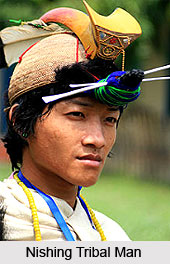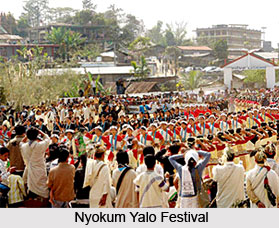 Festivals of Nishing tribe have a socio religious value. Their festivals reflect the cultural pattern of the society. Festivals are a way of life to the Nishi tribes who inhabit the Lower Subansiri and Papum Pare Districts of Arunachal Pradesh. They celebrate traditional rites and festivals family-wise and on community basis with great zeal. The two festivals - Nyokum Yalo and Langte Yalo are celebrated on community basis in grand manner in different parts of the district.
Festivals of Nishing tribe have a socio religious value. Their festivals reflect the cultural pattern of the society. Festivals are a way of life to the Nishi tribes who inhabit the Lower Subansiri and Papum Pare Districts of Arunachal Pradesh. They celebrate traditional rites and festivals family-wise and on community basis with great zeal. The two festivals - Nyokum Yalo and Langte Yalo are celebrated on community basis in grand manner in different parts of the district.
Nyokum Yalo Festival
This festival is celebrated during the winter season, in the month of February as per their traditional calendar based on agricultural activities. It is celebrated on the occasion of a new agricultural season for shifting cultivation. Though the festival stresses on agricultural operation, the rituals also play an important role.
Originally, the festival was celebrated by an individual family once a year. The rituals were performed by the elected priest of the family in the agricultural field on the day of sowing seeds. Later on for convenience it was observed village-wise as a unit in a common place. As time passed by they decided to celebrate the festival on a large scale on a fixed date, at a common place and it was renamed as Nyokum Yalo. The term indicates a ceremony in which a number of gods and spirits are to be propitiated. The duration of the festival is 3-4.
The rituals start in the evening of the preceding day, fixed for the ceremonial offering to the animals. The priest decides about the number of animals that are to be sacrificed. The rituals are performed by chanting mythical hymns. The priests ask the gods and spirits to bless the community with good harvest and prosperity.

The head priest and his assistants come near the altar and start singing mythical hymns where animals are sacrificed. The animals are tied to the altar and they are smeared with rice-powder and sprinkled with rice beer. Before the animal is slaughtered, omen with the aid of chicken liver and egg-yolk is observed. A group of youth holding long sword in their right hand dance rhythmically and this dance is called gurepiong. The priest in the end forecast about the harvest for the coming year. The priest and the participants are served with rice-beer. The meats of the sacrificed animals are kept for the community feast which takes place on the last day of the festival. The last day of the festival is marked by a community feast.
Longte Yalo Festival
The Longte Yalo or Soiling is another festival celebrated by the Nishings of Kolorinang sub-division of Lower Subansiri district. It is celebrated at the advent of a new agricultural season in the month of April. According to people the spring season commences when the local variety of palm tree starts blooming. The people prepare themselves for celebration of this annual festival.
Both the terms Longte and Yalo are used by the people to signify a festival which is concerned with erection of fencing by wooden posts on the path leading to the village, at the boundary line. A ceremony is also performed near the fencing, where the villagers seek blessings from the Donyi-polo and spirits and deities. They are appeased for bumper crop and good harvest and welfare of the people. This festival may be considered as the new year-cum-agricultural festival of the Nishing tribe. The villagers wear their traditional dress and costumes on that day. The last day of the festival is marked by a community feast.
The villagers hold two wooden posts in order to assemble at the centre of the village. The wooden posts are decorated with bamboo shavings, Kakam leaves. All the villagers gather to form a line and march towards the village boundary following the main path. The leader on reaching the spot prays for welfare and prosperity of the villagers and betterment of animals and birds. After the ceremonial installation of the fencing, the villagers return to their starting place. During these days nobody can go to the fields neither slaughter any animal. On the eighth day, the men of the village go for sports while the women enter the granary. From that day onwards people start doing their daily life activities.
















